Related Research Articles

Richard Buckminster Fuller was an American architect, systems theorist, writer, designer, inventor, philosopher, and futurist. He styled his name as R. Buckminster Fuller in his writings, publishing more than 30 books and coining or popularizing such terms as "Spaceship Earth", "Dymaxion", "ephemeralization", "synergetics", and "tensegrity".

A geodesic dome is a hemispherical thin-shell structure (lattice-shell) based on a geodesic polyhedron. The triangular elements of the dome are structurally rigid and distribute the structural stress throughout the structure, making geodesic domes able to withstand very heavy loads for their size.
Buckminster Fuller: Thinking Out Loud is a 1996 PBS American Masters documentary drama film on the inventor, visionary, and thinker R. Buckminster Fuller produced and directed by Academy Award nominees Karen Goodman and Kirk Simon. Cinematography by Buddy Squires, edited by Sara Fishko, and a production of Simon & Goodman Picture Company.

James Tennant Baldwin, often known as Jay Baldwin or J. Baldwin, was an American industrial designer and writer. Baldwin was a student of Buckminster Fuller; Baldwin's work was inspired by Fuller's principles and, in the case of some of Baldwin's published writings, he popularized and interpreted Fuller's ideas and achievements. In his own right, Baldwin was a figure in American designers' efforts to incorporate solar, wind, and other renewable energy sources. In his career, being a fabricator was as important as being a designer. Baldwin was noted as the inventor of the "Pillow Dome", a design that combines Buckminster Fuller's geodesic dome with panels of inflated ETFE plastic panels.
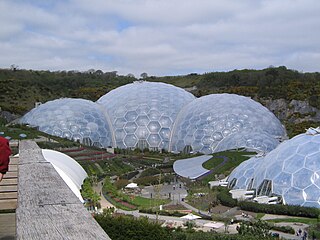
A domed city is a hypothetical structure that encloses a large urban area under a single roof. In most descriptions, the dome is airtight and pressurized, creating a habitat that can be controlled for air temperature, composition and quality, typically due to an external atmosphere that is inimical to habitation for one or more reasons. Domed cities have been a fixture of science fiction and futurology since the early 20th century, offer inspirations for potential utopias and may be situated on Earth, a moon or other planet.

The Biosphere, also known as the Montreal Biosphere, is a museum dedicated to the environment in Montreal, Quebec, Canada. It is housed in the former United States pavilion constructed for Expo 67 located within the grounds of Parc Jean-Drapeau on Saint Helen's Island. The museum's geodesic dome was designed by Buckminster Fuller.

The Gold Dome, a geodesic dome in Oklahoma City, Oklahoma, is a landmark on Route 66. It was built in 1958 and is located at the intersection of NW 23rd Street and North Classen Boulevard. It was declared eligible to be listed in the National Register of Historic Places in 2002.
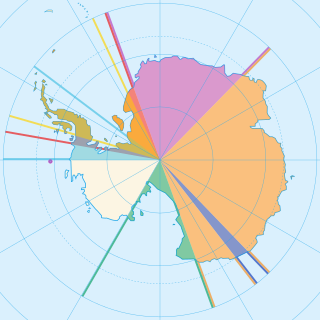
Colonization of Antarctica refers to establishment of civilian settlements in Antarctica having humans, including families, living on the continent of Antarctica. Currently, the continent hosts only two civilian colonies, the Argentinian-administered Esperanza Base and Chilean-administered Villa Las Estrellas, as well as about 70 scientific and military bases with a transient population of scientists and support staff. Antarctica is the only continent on Earth without indigenous human inhabitants, despite its proximity to Argentina and Chile at the Antarctic Peninsula.

Drop City was a counterculture artists' community that formed near the town of Trinidad in southern Colorado in 1960. Abandoned by 1979, Drop City became known as the first rural "hippie commune".

Carbondale station is an Amtrak intercity train station in Carbondale, Illinois, United States. The southern terminus of Amtrak's Illini and Saluki routes, it is also served by the City of New Orleans. Amtrak Thruway Motorcoach service between Carbondale and St. Louis, Missouri connects with the City of New Orleans. Carbondale is the southernmost Amtrak station in Illinois.
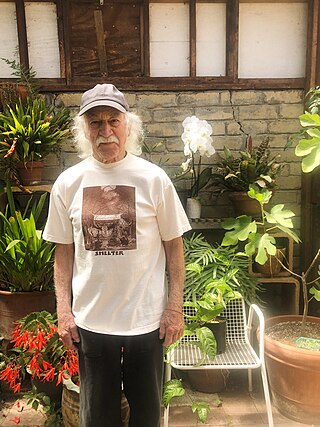
Lloyd Kahn is an American publisher, editor, author, photographer, carpenter, and self-taught architect. He is the founding editor-in-chief of Shelter Publications, Inc., and is the former Shelter editor of the Whole Earth Catalog. He is a pioneer of the green building and green architecture movements. His book Shelter (1973) about DIY architecture, has sold more than 250,000 copies.

The Geoscope was a proposal by Buckminster Fuller around 1960 to create a 200-foot-diameter (61 m) globe that would be covered in colored lights so that it could function as a large spherical display. It was envisioned that the Geoscope would be connected to computers which would allow it to display both historical and current data, and enable people to visualize large scale patterns around the world. Several projects by his students to build a "miniature Earth", starting with a 20-foot version at Cornell University in 1952, were precursors of the Geoscope proposal. Before proposing the Geoscope, Fuller had invented the Dymaxion map, a novel map projection for the whole Earth.

The ASM International Headquarters and Geodesic Dome, at the Materials Park campus in Russell Township, Geauga County, Ohio, United States, are the headquarters of ASM International, a professional organization for materials scientists and engineers. These modernist structures were built in 1958 and dedicated in September 1959.
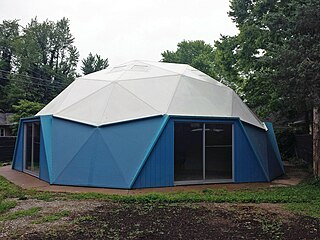
The R. Buckminster Fuller and Anne Hewlett Dome Home, located at 407 S. Forest Ave. in Carbondale, Illinois, is a geodesic dome house which was the residence of Buckminster Fuller from 1960 to 1971. The house, inhabited by Fuller while he taught at Southern Illinois University, was the only geodesic dome Fuller lived in, as well as the only property he ever owned. Fuller, a prolific architect and engineer, popularized the geodesic dome as a building design, and his house was one of the first geodesic dome residences to be constructed. The home was built and designed by Al Miller of the Pease Woodworking Company. While living in the home, Fuller was awarded nine patents, published eleven books, and designed the Montreal Biosphère, one of his most famous works.

The Last Dymaxion: Buckminster Fuller’s Dream Restored is a 2012 documentary film directed by Noel Murphy. about Buckminster Fuller's 1933 Dymaxion car as well as Fuller himself.
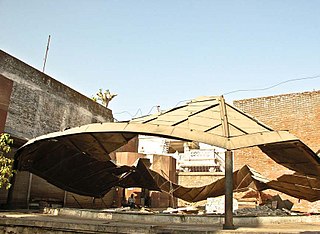
The Calico Dome, also known as Calico-shop Dome, was a geodesic dome on Relief Road, Ahmedabad, Gujarat, India. Designed by Gira Sarabhai and Gautam Sarabhai, with an inspiration from Buckminster Fuller's works, it was a combined showroom and shop for Calico Mills. It was inaugurated in 1963 and fell into disrepair when mills was closed in 1990s. It later collapsed. As of 2019, it is being reconstructed by the Ahmedabad Municipal Corporation as an industrial heritage site.
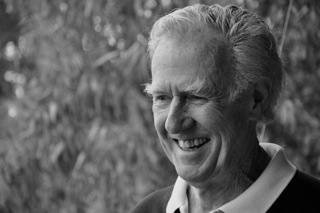
Bernard Judge was an American architect whose work in Southern California and French Polynesia was focused on environmental planning, modern architecture, and historic preservation. In 1968, Bernard Judge was awarded a United States patent for his innovative structural system based on a four-pole, pre-cut residential module. His own home in the Hollywood Hills is based on this construction. He referred to the dome as his "Triponent House."

Shoji Sadao was a Japanese American architect, best known for his work and collaborations with R. Buckminster Fuller and Isamu Noguchi. During World War II he was stationed in Germany and was a cartographer for the U.S. Army.
The Fly's Eye Dome was a structure designed in 1965 by R. Buckminster Fuller. Inspired by the eye of a fly, Fuller designed the dome as his idea of the affordable, portable home of the future, with windows and openings in the dome to hold solar panels and systems for water collection, thus allowing the dome to be self sufficient. Before his death in 1983, he hand-built three prototypes of the design:
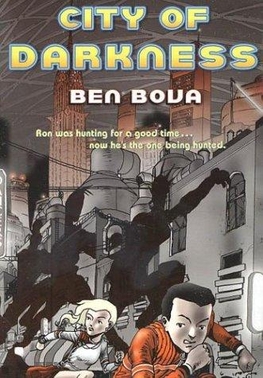
City of Darkness is a dystopian young adult novel by Ben Bova, first published in 1976.
References
- ↑ Carlson, Jen. "The 1960 Plan To Put A Dome Over Midtown Manhattan". Gothamist. Archived from the original on 2019-05-12. Retrieved 2019-05-12.
- ↑ "A 1960s Plan to Cover Midtown Manhattan With a Giant Geodesic Dome". 6sqft. Retrieved 2019-05-12.
- 1 2 Budds, Diana (2016-03-31). "How Buckminster Fuller Made A Dome Over Manhattan Sound Sensible". Fast Company. Retrieved 2021-03-14.